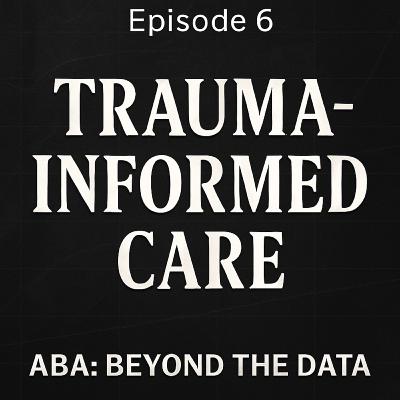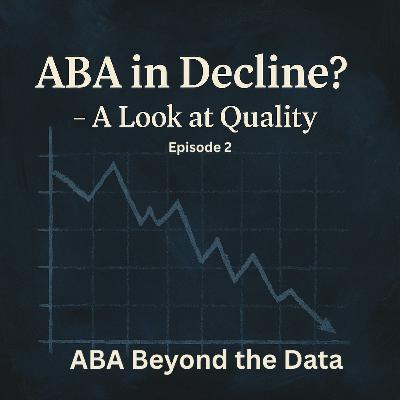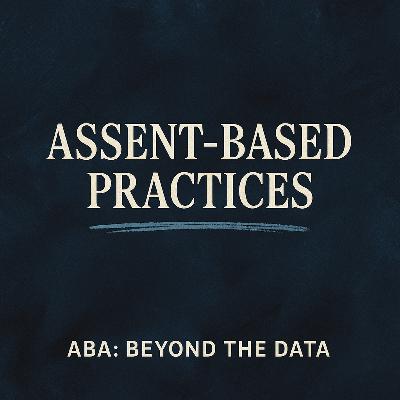Discover ABA Beyond the Data
ABA Beyond the Data

ABA Beyond the Data
Author: J. L. Burton, MA, BCBA, LBA
Subscribed: 1Played: 0Subscribe
Share
© J. L. Burton, MA, BCBA, LBA
Description
ABA: Beyond the Data is an ACE-approved podcast where you can earn CEUs while exploring the practice of Applied Behavior Analysis from two unique perspectives. Hosted by Jay Burton, a seasoned BCBA and parent of two wonderful boys on the autism spectrum, this show blends professional expertise with personal experience. Each episode dives into real-world challenges, fresh ideas, and practical strategies designed to improve your clinical work while keeping humanity and compassion at the core of ABA.
6 Episodes
Reverse
CEU info: This episode qualifies for Ethics CEU. Listen for the three keywords and submit them at aba-ceu.com to claim your CEU.“Trauma-Informed Care in ABA” gets practical about something that’s often treated like a slogan. We start by defining trauma in plain language—acute, chronic, and complex—and focus on impact: how histories of unpredictability and lost agency change what feels safe, how fast escape becomes the best option, and what that means for the contingencies we arrange. From there we connect the dots to modern, assent-based ABA: predictable openings, real choices, a clean “pause” pathway, simple communication that works immediately, humane delays, and micro-successes during waits. If you’ve heard our “My Way” episode, you’ll recognize the backbone—communication → tolerance → cooperation—applied deliberately through a trauma-informed lens.We also confront the training gap. Most behavior analysts endorse trauma-informed practice but report little formal preparation. So we close it with a supervisor toolkit: four 15-minute micro-modules (safety and predictability; assent and choice; reinforcement-first teaching; compassionate care skills), concrete behavior goals (four authentic choices per 10 minutes; honor opt-out in ≤3s; 4:1 acknowledgments; a “first five minutes” script), tight role-plays with checklists, IOA on assent recognition, and small weekly huddles that post real data the team can see. If a safety procedure is ever unavoidable, we frame it as a temporary, data-based exception with pre-brief criteria, informed consent, debrief, and an immediate plan to fade via skill building.By the end, you’ll have a clear way to show that trauma-informed ABA is not extra; it’s the Ethics Code in action. You’ll know how to document not just behaviors reduced but harms avoided—fewer holds, fewer room clears, more observable assent, faster re-engagement, and caregiver reports of “felt safe” and “would do again.” And you’ll have language you can use tomorrow that keeps sessions humane, effective, and deeply behavior-analytic.Who it’s for: BCBAs, BCaBAs, and RBTs who want compassionate, research-aligned practices that improve engagement and outcomes in autism intervention—and clinic leaders who need an actionable plan to coach and measure this work.Sources (selected):Hanley, G. P., Rajaraman, A., Gover, H. C., & Staubitz, J. L. (2022). Toward trauma-informed applications of behavior analysis. Behavior Analysis in Practice.Taylor, B. A., LeBlanc, L. A., & Nosik, M. R. (2018). Compassionate care in behavior-analytic treatment. Behavior Analysis in Practice.Wheeler, K. (2024). Behavior analysts’ training and practice regarding trauma-related concepts. Behavior Analysis in Practice.Gover, H. C., Rajaraman, A., & Weiss, M. J. (2024). Incorporating trauma-informed care strategies into assessment and intervention for food selectivity.Hanley, G. P., et al. (2014). Skill-Based Treatment (“My Way”) and synthesized contingencies. Journal of Applied Behavior Analysis.Rohrer, H. M., Jessel, J., & Hanley, G. (2021). Assent-based practice. Behavior Analysis in Practice.CASP (2024). Practice Guidelines 3.0. Visit: https://aba-ceus.com
How to get your CEU: To earn 1.0 BACB CEU for this episode, go to aba-ceu.com, select “Episode 5: Implementing the ‘My Way’ Strategy,” and complete the short quiz. You’ll need the three keywords—Communication, Tolerance, and Assent. Submit to receive your certificate instantly.This episode of ABA Beyond the Data takes you from research to real-world practice with the “My Way” approach—an assent-based, skill-building model for safely replacing severe problem behavior. We start with why Hanley and colleagues’ 2014 study was a turning point: rather than isolating a single function or relying on extinction-heavy procedures, they synthesized the contingencies that co-occur in family life—attention, tangibles, escape—and taught a better route to the same outcomes. In plain terms: teach a powerful request, teach a calm “Okay” to brief denials, then fill the wait with tiny, doable actions that build independence.From there, we map implementation step by step in the show’s practical, conversational style. You’ll hear how to run the open-ended interview and confirm the “knot” of contingencies with a brief synthesized analysis. We teach the omnibus FCR (“My way, please”), shape the polite chain (“Excuse me.” → “May I have my way, please?”), and move into tolerance training where “not now” becomes a cue for regulation, not escalation. You’ll learn to extend short delays without losing assent, and to embed response chains—simple, appropriate actions during the wait—so cooperation becomes the fastest route back to what matters.We also cover the messy middle. You’ll learn how to coach RBTs with behavior skills training (model → role-play → feedback), how to keep sessions safe and humane, and what to do when old patterns flicker—shrinking delays, simplifying tasks, and sweetening the contrast for calm, independent responding. We talk through parent concerns with empathy—showing that “My Way” doesn’t trade effectiveness for kindness; it delivers both. And we outline adaptations for non-vocal learners using AAC, signs, or switches, while keeping the core sequence intact: get attention, make the omnibus request, accept “not now,” complete a tiny task, access preferred outcomes.By the end, you’ll have a clinic-to-kitchen roadmap—and a clean data package to prove it’s working: independent FCRs up, independent tolerance up, problem behavior near zero, reinforcement time shifting as flexibility grows, and brief tasks completed without physical guidance. Most of all, you’ll hear what this sounds like at home: quieter rooms, calmer voices, and kids who feel safe enough to try again tomorrow. Because “My Way” isn’t a one-off protocol; it’s a process—Communication → Tolerance → Adaptation—held together by fidelity and compassion. When kids feel heard, we don’t need to take their control away to teach them. We show them how to use it.SEO: BCBA, ABA therapy, CEUs, ACE Provider, Applied Behavior Analysis, autism, continuing education, podcast, Functional Communication Training, IISCA, PFA, Skill-Based Treatment, compassionate ABA, assent-based ABA.SourcesHanley, G. P., Jin, C. S., Vanselow, N. R., & Hanratty, L. A. (2014). Producing meaningful improvements in problem behavior of children with autism through synthesized reinforcement and skill-based treatment. JABA, 47(1), 16–36.Jessel, J., Hanley, G. P., & Ghaemmaghami, M. (2016). Interview-informed synthesized contingency analyses. JABA, 49(2), 359–376.Ghaemmaghami, M., Hanley, G. P., & Jessel, J. (2021). A review and practical summary of skill-based treatment research. JABA, 54(3), 1045–1072.Rohrer, M. W., Jessel, J., & Hanley, G. P. (2021). Assent-based practice. Behavior Analysis in Practice, 14(3), 566–582.Council of Autism Service Providers (2024). ABA Practice Guidelines (Section 4).
Episode 4: Beyond the Drama — Toxic Workplaces in ABA (and How to Fix Them)If you’ve worked in ABA long enough, you’ve probably seen it — the drama, the gossip, the burnout, and the revolving door of staff turnover. Some clinics run like a well-oiled machine, while others feel more like a reality TV show with data sheets. In this episode of ABA Beyond the Data, we’re going to unpack why toxic and drama-filled workplaces are so common in our field and, more importantly, what we can actually do to change them.I’m your host, Jay Burton, BCBA and parent of two boys on the autism spectrum, and today we’re going beyond the drama to look at the research, the realities, and the real-world solutions for creating healthier, more sustainable ABA environments.We’ll start by exploring what creates toxic culture in the first place — things like unclear leadership, unrealistic caseloads, and negative social norms that spread faster than a cold in the clinic playroom. From there, we’ll look specifically at how stress and burnout feed that culture. You’ll hear about RBTs running from client to client without support, BCBAs buried under paperwork and parent meetings, and how poor work design sets everyone up to fail.Then, we’ll talk about gossip, bullying, and incivility — the unspoken realities of many ABA workplaces. We’ll get honest about the “RBT group chat,” leadership avoidance, and the way small cliques and side conversations can quietly destroy team trust. Most importantly, we’ll discuss how to stop it — by defining values, setting boundaries, and reinforcing professionalism the same way we reinforce any other behavior: through consistency.Next, we’ll shift focus to leadership and accountability. Research from Sloan Management Review and Berkeley Executive Education shows that culture starts at the top. Leaders who model respect, transparency, and work-life balance create clinics that thrive. Those who model burnout, gossip, or avoidance? Their teams follow suit. We’ll break down what healthy leadership looks like in ABA — from setting realistic caseloads to building psychological safety where staff feel safe asking for help.And because we’re not stopping at the problems, we’ll wrap up with solutions. You’ll learn how to redesign work, establish clear communication systems, and build team structures that reduce isolation and drama. We’ll also talk about the importance of staff wellness — breaks that actually happen, debriefs after tough sessions, and peer support systems that prevent burnout before it starts.At the heart of it all, this episode isn’t just about fixing clinic culture — it’s about remembering why we’re here in the first place. As a parent, I want my kids’ therapists to love coming to work. Because when staff thrive, kids thrive.If you’ve ever felt drained, frustrated, or caught in workplace drama, this episode is for you. Let’s look at how to move past the chaos and build something better — for ourselves, for our staff, and for the families we serve.🎧 Listen to Episode 4: Beyond the Drama on Apple Podcasts, Spotify, Amazon Music, or YouTube.🎓 Earn your CEUs for this episode at aba-ceus.com — just listen for the three key words throughout the episode.I’m Jay Burton, and this is ABA Beyond the Data.
Welcome back to ABA Beyond the Data! In this episode, we dive deep into the TEACCH model—what it is, how it’s implemented, and why it matters for ABA practice today. If you’re looking to earn CEUs for this episode, you can purchase them at https://aba-ceus.com/get-ceus.com. You’ll need the three key words hidden throughout the episode to complete your purchase.TEACCH—short for Treatment and Education of Autistic and related Communication-handicapped Children—originated at UNC in the 1970s. It emphasizes structure, predictability, and independence through four core elements: physical organization, individualized schedules, structured work systems, and visual clarity. But what does this actually look like in practice, and how does it fit alongside ABA?In this episode, I’ll cover:What TEACCH is: its history, philosophy, and why it has stood the test of time.How TEACCH is implemented: from pod structures and schedules to task boxes and routines.What the research says: evidence showing improvements in social functioning, adaptive skills, and independence.TEACCH + ABA: how structured teaching complements behavior analysis, with overlaps in antecedent strategies, task analysis, and environmental arrangement.Clinic-wide application: what it looks like to run a clinic using TEACCH-inspired systems, including real-life examples from my own practice.As both a BCBA and a parent of two boys on the spectrum, I’ll share professional insights and personal reflections—like how structured environments have been a game-changer not only in clinics but in my own home. You’ll also hear about challenges, like staff training and balancing flexibility with structure, and practical tips for starting small and scaling up.Most importantly, we’ll tackle a common misconception: that structure equals less fun. In reality, a good schedule creates more fun by opening doors to new activities, smoother transitions, and greater confidence for our learners. At my clinic, that means playrooms, art projects, trampolines, and rock walls—all embedded into a schedule that keeps the day moving and enjoyable.
How to get CEUsEarn CEUs for this episode at aba-ceus.com! Each CEU is just $7. To complete your purchase, you’ll need the 3 key words hidden throughout the episode—so make sure to listen from start to finish. Affordable, simple, and designed for BCBAs who want continuing education that goes beyond the data.Episode Summary:The episode explores the rapid growth of the field, with BACB reporting a 58% increase in BCBA demand in one year. More providers doesn’t always mean better care—new clinics expand quickly, often promoting first-year BCBAs into leadership roles without proper support.Research is clear: supervision and caseloads predict outcomes (Dixon et al., 2016; Kranak et al., 2023). Yet overloaded analysts can’t provide quality oversight. If you’re forgetting clients’ names, you don’t have a caseload—you have a zip code.Treatment fidelity is another challenge. Without checks, three therapists may run the same program three different ways. That’s not ABA—that’s interpretive dance. Consistency is essential, but fidelity reporting remains inconsistent (Falakfarsa et al., 2021; Morris et al., 2024).At the system level, contingencies often reward profit over practice (Silbaugh et al., 2021). Billing pressures, staffing shortages, and productivity goals undermine care. Add burnout (Slowiak et al., 2021, 2023), and turnover becomes the norm—hurting kids and families most.Jay closes with key takeaways and practical fixes: advocate for reasonable caseloads, invest in supervision training, standardize fidelity checks, and prioritize staff retention and wellness. Because, as Dr. Seuss wrote: “Unless someone like you cares a whole awful lot, nothing is going to get better. It’s not.ReferencesSupervision & CaseloadsDixon, M. R., Bergstrom, R., Smith, M. N., & Tarbox, J. (2016). Supervision intensity and credential type influence skill acquisition for children with autism. Behavior Analysis in Practice, 9(4), 338–348. https://doi.org/10.1007/s40617-016-0130-xKranak, M. P., Falligant, J. M., Zlomke, K. R., Briggs, A. M., Gregory, M. K., Fales, J. L., & Carnett, A. (2023). A systematic review of supervision in behavior analysis. Behavior Analysis in Practice. Advance online publication. https://doi.org/10.1007/s40617-023-00898-9Treatment FidelityFalakfarsa, T., Carroll, R. A., Kodak, T., & LeBlanc, L. A. (2021). A review of treatment integrity in applied behavior analysis. Behavior Analysis in Practice, 14(4), 1016–1031. https://doi.org/10.1007/s40617-021-00595-2Morris, E. K., Vollmer, T. R., Slowiak, J. M., & Mace, F. C. (2024). How to measure and maintain fidelity in applied behavior analysis services. Behavior Analysis in Practice. Advance online publication. https://doi.org/10.1007/s40617-024-00992-5System-Level Quality ConcernsSilbaugh, B. C., Penrod, B., & Shillingsburg, M. A. (2021). The behavior of the ABA service industry: A conceptual analysis of quality. Behavior Analysis in Practice, 14(4), 1129–1143. https://doi.org/10.1007/s40617-021-00565-8Workforce Supply & DemandBehavior Analyst Certification Board (BACB). (2025). US Employment Demand for Behavior Analysts: 2010–2024. Littleton, CO: Author. Retrieved from https://www.bacb.comBurnout & Practitioner WellbeingSlowiak, J. M., Huitema, B. E., & Dickinson, A. M. (2021). Burnout in applied behavior analysis: The role of job demands and resources. Behavior Analysis in Practice, 14(2), 338–352. https://doi.org/10.1007/s40617-020-00520-1Slowiak, J. M., Feiock, C. W., & Rawe, B. M. (2023). Predictors of burnout among BCBAs: A longitudinal analysis. Journal of Applied Behavior Analysis, 56(2), 413–431. https://doi.org/10.1002/jaba.995
To buy the CEU for only $7 go to:https://www.aba-ceus.com/get-ceus/p/episode-1-ceuIn this episode of ABA Beyond the Data, I, Jay Burton—BCBA and proud parent of two incredible boys on the autism spectrum—take a deep dive into one of the most important and often misunderstood concepts in our field: assent.We start by breaking down what assent really means. Consent is legal and informed; assent is the learner’s active “yes.” It’s not passive silence, and it can be withdrawn at any time. Recognizing assent and dissent is essential, especially for our learners who may communicate non-vocally. Leaning in, smiling, or reaching for materials may show assent, while turning away, pushing items aside, or hiding under the table may signal dissent.I share openly about my own journey as a clinician and as a dad. For too long, I was a “follow through no matter what” BCBA, and I saw how that damaged my relationship with my older son. When I shifted to assent-based practices, the trust that grew between us was undeniable. With my younger son, who has only known an assent-based approach, our relationship looks completely different—there’s less conflict and more connection.We also cover what to do when assent is withdrawn. Sometimes you don’t re-present the task, sometimes you re-present later, and sometimes you modify the conditions. I share the story of my son Lucas saying “no” to shoes—a breakthrough early word that I happily honored, because teaching our kids the power of their own voice matters more than compliance.Of course, there are moments when assent can’t be the deciding factor. Safety, health, and dignity always override. Crossing the street, getting medical care, or basic hygiene like brushing teeth—these are not optional. But even in non-negotiable situations, we can build in choice and dignity by offering flexibility and respecting the learner’s voice where possible.At the heart of this episode is a message of growth and honesty. Assent isn’t just ethical, it’s humane. It builds trust, reduces coercion, and teaches lifelong skills of choice and advocacy. And yes—sometimes dissent looks like hiding under a table with a Pop-Tart. Don’t call it an extinction burst; call it a Yelp review.If you’d like to earn CEUs for this episode, head to ABA-CEUS.com, answer three quick questions, and you’ll get credit.📚 Sources CitedBreaux, R. P., & Smith, T. (2023). Moving beyond compliance: Assent-based practice in applied behavior analysis. Behavior Analysis in Practice.Behavior Analyst Certification Board (BACB). (2020). Ethics Code for Behavior Analysts. Littleton, CO: BACB.United Nations. (2006). Convention on the Rights of Persons with Disabilities (CRPD).










